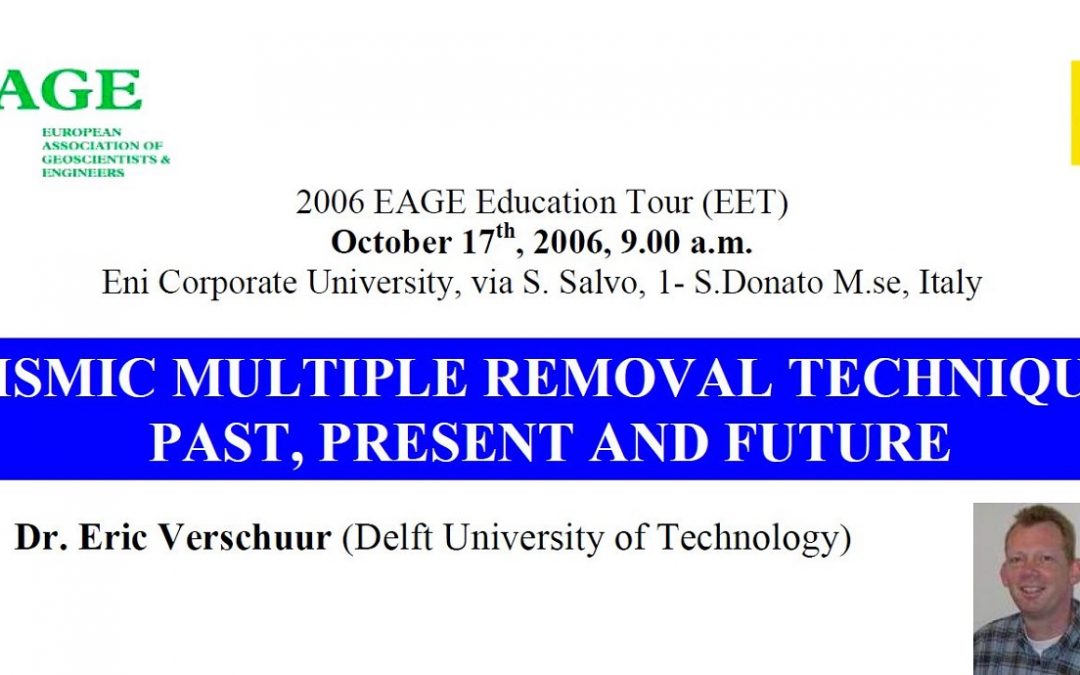Dr. Eric Verschuur (Delft University of Technology)
SEISMIC MULTIPLE REMOVAL TECHNIQUES:
PAST, PRESENT AND FUTURE
2006 EAGE Education Tour (EET)
October 17th, 2006, 9.00 a.m.
Eni Corporate University, via S. Salvo, 1- S.Donato M.se, Italy
The main objective of this course is to give the audience an overview of the techniques in seismic multiple removal, starting with the deconvolution-based methods from the 1960’s, via the move-out discrimination techniques of the 1980’s and ending up with wave-equation based methods from the 1990’s and their 3D extensions as developed in the 2000’s. Furthermore, the current challenges in multiple removal and their relation with seismic imaging and inversion are treated. A secondary objective is to discuss more general processing concepts such as high-resolution seismic data transforms (Fourier, Radon), adaptive filtering techniques, wave-equation based forward and inverse wave propagation and the processing of seismic data in different transform domains. The lectures will be accompanied by a booklet with handouts of all slides, accompanied by some extra comments. At the end of each lecture, a list of relevant articles in the open literature will be specified. The course is subdivided in 10 lectures, each of them being approximately 30-45 minutes. Within each lecture, examples of the described concepts on synthetic and field data will play an important role.
The list of the lectures is as follows:
- Multiples … what’s the problem?
- Predictive deconvolution and adaptive filtering
- Multiple removal by move-out discrimination
- Wavefield extrapolation principles
- Principles of surface-related multiple elimination (SRME)
- SRME: implementations and applications
- Adaptive subtraction of predicted multiples
- 3D problems and solutions
- Internal multiple removal
- Removing or using multiples?D FUTURE
- Multiples … what’s the problem? Classification of multiple reflections. Physical behavior of multiples. Impact on seismic imaging and inversion: kinematical and dynamic effects. Quick overview of multiple removal methods.
- Predictive deconvolution and adaptive filtering. Basics of predictive deconvolution. Convolution and correlation concept. Designing adaptive filters by least-squares minimization. Alternative filtering techniques.
- Multiple removal by move-out discrimination. Basics of move-out discrimination filtering techniques. Resolution aspects of the FK and Radon transform, High-resolution wavefield transforms: Fourier, Generalized Radon. Alternative move-out filters: FK, KL and SVD techniques.
- Wavefield extrapolation principles. Huygens’ principle, Kirchhoff summations and stationary points. Forward and inverse wavefield extrapolation. Multiple prediction by wavefield extrapolation. Application in the space frequency versus tau-p domain. Relation with predictive deconvolution.
- Principles of surface-related multiple elimination (SRME). Intuitive mathematical derivation for 1D situation. Influence of the source wavelet on data-driven multiple removal. Iterative application of SRME versus full series expansion. Extension of the theory to 2D and 3D.
- SRME: implementations and applications. Effect of source/receiver sampling and missing offsets. Interpolation of missing near offsets. Application of SRME in different domains: Shot/CMP/Post-stack. Shallow water multiple removal strategy. Relation with other multiple removal techniques.
- Adaptive subtraction of predicted multiples. Least-squares (L2-norm) subtraction. L1-norm subtraction. Pattern recognition and other multiple matching methods.
- 3D problems and solutions. Multiples in complex 3D areas: out-of-plane reflection and diffraction. Extending the 2D techniques to a quasi 3D method. Full 3D SRME implementations, relation with data interpolation.
- Internal multiple removal. Physical analysis of internal multiples: deterministic or statistical behavior? Application of move-out discrimination to internal multiples. Extensions of SRME to handle internal multiples.
- Removing or using multiples? Transforming multiples into primaries. Extracting surface and subsurface information from multiples. Including multiples in the migration scheme. Including multiples in a non-linear inversion scheme. Transforming multiples into primaries. Extracting surface and subsurface information from multiples. Including multiples in the migration scheme. Including multiples in a non-linear inversion scheme.
WHO SHOULD ATTEND
The target audience is composed of people involved in seismic processing, imaging and inversion. The mathematical content is kept to a minimum level with a strong link with the involved physical concepts, amplified by graphical illustrations. The audience is expected to have prior knowledge at B.Sc./M.Sc. level on processing concepts as convolution, correlation and Fourier transforms and some basic knowledge on wave theory.
BIOGRAPHY
Kurt Dirk J. (Eric) Verschuur received his M.Sc. degree in 1986 and his Ph. D degree (honors) in 1991 from the Delft University of Technology (DUT), both in applied physics. From 1992 – 1997 he worked under a senior research fellowship from the Royal Dutch Academy of Art and Sciences (KNAW). In 1997 he became assistant professor and since 1999 he is an associate professor at the DUT at the laboratory of Acoustical Imaging and Sound Control. He is the project leader of the DELPHI research consortium in the area of Multiple Removal and Structural Imaging. His main interests are seismic modeling, processing and migration techniques. In 1997 he received SEG’s J. Clarence Karcher award. He is a member of SEG and EAGE.


Recent Comments